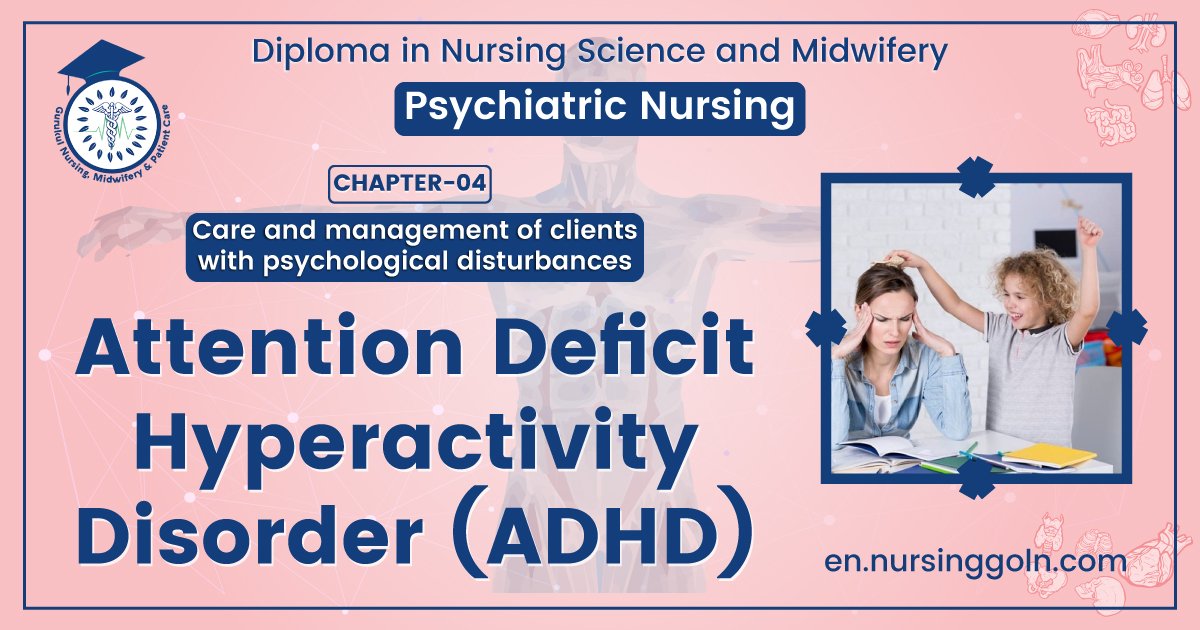Attention deficit hyperactivity disorder (ADHD) – This book covers the entire syllabus of “Psychiatric Nursing” prescribed by the Universities of Bangladesh- for Basic and diploma nursing students. We tried to accommodate the latest information and topics. This book is an examination-friendly setup according to the teachers’ lectures and examination questions.
At the end of the book previous university questions are given. We hope in touch with the book students’ knowledge will be upgraded and flourish. The unique way of presentation may make your reading of the book a pleasurable experience.

Attention deficit hyperactivity disorder (ADHD)
A biochemically based disorder of behavior and attention that results in a persistent pattern of difficulty affecting a child’s functioning at home, school, and socially. Symptoms must be outside of the range of normal behavior for developmental level.
[Ref: Clinical Consult to Psychiatric Nursing/1/317)
Characteristics of attention deficit hyperactivity disorder:
1. An inability to pay attention or to sustain attention.
2. Always on the move, as if driven by a motor.
3. Impulsivity-verbally and physically.
4. Symptoms interfere with multiple life domains.
5. School, social, home, or work.
6. Symptoms must be present before the age of 7 years.
[Ref: Clinical Consult to Psychiatric Nursing/1/3171
Risk factors for ADHD.
1. Gender
➤ Male
2. Family History
➤ Family members with ADHD
➤ Heritability is estimated at greater than or equal to 75%.
3. Precipitating Factors
➤Infections
➤ Head injury
➤ Hypoxia
➤Exposure to drugs or alcohol in utero
➤Low birth weight
4. Comorbidity Factors

➤ Higher incidence of chronic health conditions than in non-affected children
➤ High incidence of substance use and abuse
➤ Six times more likely to have psychiatric comorbidities
➤ ODD and conduct disorder (CD)
➤ Developmental disorders
➤ Learning disorders
➤ Anxiety disorders
➤ Mood disorders
➤ Sleep problems
➤ Difficulty winding down and falling asleep
5. Socioeconomic Factors
➤ Children from single-mother families are more likely to have an ADHD diagnosis.
➤ Children with Medicaid are more likely to have an ADHD diagnosis than privately insured children.
➤ Adolescents with ADHD are more likely to drop out of school.
➤ Higher rates of pregnancy among high school girls
➤ Higher incidence of legal involvement
➤ Higher incidence of auto accidents
[Ref: Clinical Consult to Psychiatric Nursing/1/318)
DSM-5 Diagnostic Guidelines:
Inattention Symptoms:
Six or more of the following symptoms of inattention are present for at least 6months, to a degree that is maladaptive:
1. The individual fails to give attention to details, in schoolwork, or other activities.
2. Has difficulty in sustaining attention in performance of tasks
3. Does not seem to be listening when spoken to directly
4. Fails to follow through on instructions, fails to complete school work or other duties (with failures not attributable to confrontational behavior or failure to understand instructions)
5. Has difficulty in organizing tasks and other activities
6. Seeks ways to circumvent tasks that require mental effort
7. Often loses things
8. Individual is easily distracted by stimuli of many kinds.
9. Individual is, more often than not, forgetful in daily activities.

The DSM-5 lists these symptoms as being diagnostic of ADHD:
1. Has difficulty finishing any activity that requires concentration
2. Does not seem to listen to anything said to him or her
3. Is excessively active-running or climbing at inappropriate times, squirming in or jumping out of his or her seats
4. Is very easily distracted
5. Talks incessantly, often blurting out responses before questions are finished
6. Has serious difficulty waiting his or her turn in games or groups
7. May have specific learning disabilities
Hyperactivity-Impulsivity Symptoms:
Six or more of the following symptoms have persisted for at least 6 months, to a degree that is maladaptive:
1. The individual fidgets or squirms when seated.
2. Leaves seat in classroom or in other situations in which remaining seated is required
3. Runs about in environments in which it is inappropriate to do so
4. Has difficulty in engaging in leisure activities quietly
5. Is always on the go
6. Talks excessively
7. Gives answers to questions before questions have been fully verbalized
8. Has difficulty in waiting for his or her turn
9. Interrupts the speech of others or intrudes in the activities of others
10. In adolescents and adults: the presence of feelings of extreme restlessness
11. Symptoms are present before the age of 7 years. 12. Social deficits are present in two or more settings.
13. Clear evidence of impairment in social functioning
14. The symptoms do not occur concurrently with and exclusively during the course of a PDD, schizophrenia, or other psychotic disorder, and are not more readily ascribed to another psychiatric condition.
[Ref: Clinical Consult to Psychiatric Nursing/1/319-320)
Treatment overview:
Acute Care:
1. Health care providers should be familiar with the multiple medications available to treat ADHD. Stipulant medications are first-line agents. Atomoxetine (Strattera) is a second-line agent and has been shown to be effective in placebo-controlled trials.
2. Other medications with less extensive evidence to support their use include alpha-2-agonists (Intuniv).
Chronic Care:
1. Behavior modification, also called behavior therapy, is recommended as part of a total treatment plan for ADHD
2. It is based on rewarding an individual for desired behaviors and having consequences for undesired behaviors. Rewards and point systems are effective when used consistently at school and home.
3. It can help build self-esteem and guide the patient toward good behavior patterns.
4. Create schedules and follow routines daily
5. Keep tasks simple
6. Help the child become organized
7. Use brief and clear instructions
8. Limit distractions (e.g., TV, radio, games) when the child is doing homework.
9. Set SMART goals to track the child’s progress:
- S Specific: Develop specific goals that are clearly stated.
- M-Measurable: A goal is measurable if progress is made toward reaching it.
- A Agreed upon: Talk about the goal with the child and agree on actions.
- R=Realistic: The goals should be within reach,
- T=Timely: A timely goal is one that can be achieved within a time frame that is meaningful.

10. Stimulants:
- Immediate release
- Extended release
- Medications to treat ADHD can create sleep disturbance.
- Rebound appetite
- Twenty percent of patients do not respond to stimulants.
- For patients with substance abuse issues choose stimulants with nonabuse formulations.
11. Non-stimulants
- Atomoxetine (Strattera)
- Black box warning
- Analysis of 12 studies revealed that 4 out of 1,000 children experienced suicidal thoughts. There were no actual suicides in the studies. (Ref: Clinical Consult to Psychiatric Nursing/1/320)
Read more:
